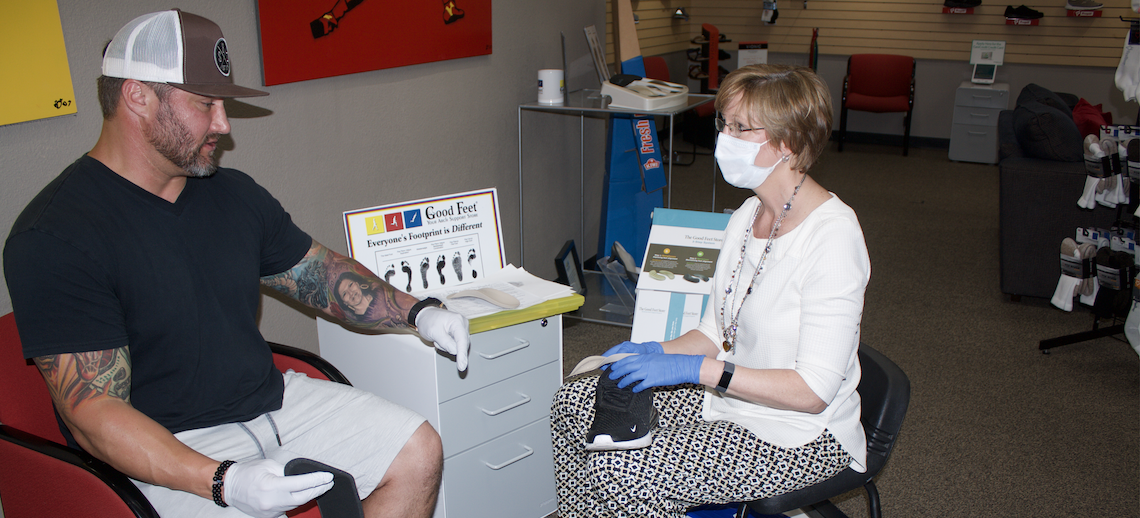
Good Feet Store co-owner Beth Schneider does a fitting for a customer in this April 2020 photo. Their store was deemed an essential business and allowed to operate in the heat of the pandemic. Photo by Donald Promnitz
Written by Ben Hensley
California recently marked the four-year anniversary of the first government action taken in response to the outbreak of the Coronavirus, cutting the ribbon to some of the most challenging, anxiety-inducing and potentially dangerous varieties of response and prevention that the state and county has ever seen.
March 4, 2020, was the date when California Gov. Gavin Newsom declared a state of emergency due to the then-novel Coronavirus, a response to 50 positive test results and, at the time, one fatality.
At that time, the concept of stay-at-home orders, mandated business shutdowns and terms like “essential workers” were completely foreign concepts to a majority of Americans.
Four years later, business seems to be more or less returning to “normal,” according to some Fresno business owners — albeit with some new tools at their disposal and the knowledge that comes from having survived, and in some cases, thrived, during the pandemic.
Once stay-at-home orders came down from Sacramento and many states across the country, businesses had to quickly pivot from standard typical foot-traffic based business models to new approaches including online delivery services and curbside pick-up.
“We’ve never had a strong online presence in terms of retail,” said Kris Aoki, general manager at Gottschalk Music Center in Clovis. “We are, at the very core of our company, a brick and mortar retail business that specializes in the music industry; we, for better or worse, have found a way to make it all work.”
Aoki said that having a flexible workforce was essential to keeping day-to-day operations as normal as possible; despite being required to temporarily furlough some of his staff, once retail was allowed to reopen during the summer of 2020, most of his employees returned.
After returning, however, Aoki said the store’s way of doing business shifted dramatically.
Prior to the pandemic, the store was home to a studio with space for in-person lessons. The pandemic required much of the lesson space to be converted into storage for instruments — as the business also facilitates the renting of instruments to schools throughout the Valley.
“The school system’s budget did not change,” Aoki said. “There was a shift in what they started to buy — they started to buy PPE…the manufacturers that we worked with and the suppliers that we worked with started making stuff like that.”
While Gottschalk Music Center was forced to change some of its day-to-day operations, other retailers in the area also pivoted quickly from in-person shopping to curbside and online ordering.
Many retailers have retained that practice to this day, able to capitalize on a new market of customers that prefer curbside pick-up.
Ian Williams, general manager and owner of Fresno Ag Hardware, said that a large portion of his customer base still prefers online shopping and curbside pick-up.
“Online sales absolutely crushed it better than expected,” Williams said. “That has really been steady and growing whereas inside sales have dipped a little bit.”
In-store sales have not taken a major hit — only around 10% — but have been supplemented by online ordering and curbside pick-up.
“In March of 2022, I wrote a memo to the team – we’re starting an e-commerce task force,” Williams said, committing an entire crew to fulfilling online orders. “The ‘why’ is important. You want to always have a reason…we want to be fast.”
Williams said that since the pandemic, the team at Fresno Ag Hardware has been able to continue to build his customer base by embracing online ordering and several other techniques required during the pandemic.
Local restaurateur Dave Fansler said that while the pandemic caused a major shift and much frustration for business owners, there were some takeaways that continue to benefit both retail and food businesses.
“The take-out business really picked up during the pandemic,” Fansler said. “People got used to that and it’s formed a new habit.”
He said that restaurants have been able to capitalize on take-out options, with some restaurants opting to focus more on take-out than dine-in.
On the other hand, however, Fansler said that the employee mindset has changed, pointing towards government assistance during the pandemic which saw employees earning as much, if not more, than they could have earned while putting work in at the restaurant.
“You have a much higher-expectant employee,” Fansler said. “They’re just highly expectant after the government paid them over $3,000 a month for a long period of time. They had these long periods of unemployment and restaurants were begging for employees and couldn’t get them.”
Fansler said that that mindset has dwindled but does still remain in some employee candidates that he has seen.
“I think the government has to be very careful,” Fansler said. “I think they see that society will never again allow such an encompassing lockdown; this was a one-shot deal, and I don’t think they’ll ever get it again.”
Despite many in the restaurant and retail business echoing the same sentiment, many of them say that some of the benefits that came out of the pandemic — specifically online retail — are here to say.








